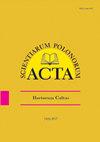Morphological and biochemical diversity in Rosa species
IF 0.7
4区 农林科学
Q4 HORTICULTURE
引用次数: 0
Abstract
The Rosa L. is one of the widely grown plants in the world and its flowers and fruits has been used in different parts of the world for centuries. Wild grown Rosa plants is one of the most important element of the natural landscape and used as rootstock for roses for centuries as well. In this study the main flower, shrub and fruit characteristics of a large number of Rosa canina L. and Rosa dumalis Bechst. genotypes naturally found in Ardahan province of Turkey has been studied. All plants found very health conditions and indicated their strong defense mechanism of the genera to harsh abiotic and biotic conditions. The majority of genotypes had attractive flowers. The genotypes exhibited fruit mass between 2.81 g to 4.60 g. SSC (soluble solid content), vitamin C, total phenolic, total flavonoid, total carotenoid, and total anthocyanin content of the genotypes ranged from 15.8–20.6%, 502–714 mg per 100 g FW (fresh weight), 405–507 mg gallic acid equivalent per 100 g FW, 1.02–2.00 mg per g FW, 8.40–13.30 mg per g FW and 4.35–6.98 mg cyanidin-3-glucoside equivalent per liter, respectively. Antioxidant activity was determined between 22.3–30.9 mg ascorbic acid equivalent per g fresh weight. Chlorogenic acid was the major phenolic acids in fruits of Rosa ecotypes. Our results indicated promising perspectives for usage of R. canina and R. dumalis fresh fruits studied with considerable levels of bioactive compounds.蔷薇属植物形态和生化多样性
蔷薇是世界上广泛种植的植物之一,其花和果实在世界各地已经使用了几个世纪。野生蔷薇植物是自然景观中最重要的元素之一,几个世纪以来也被用作玫瑰的砧木。本研究主要研究了大量犬齿蔷薇和杜马蔷薇的花、灌木和果实特征。对土耳其阿尔达汉省自然发现的基因型进行了研究。所有植物都发现了非常健康的条件,并表明了属对恶劣的非生物和生物条件的强大防御机制。大多数基因型都有吸引人的花朵。这些基因型的果实质量在2.81克至4.60克之间。SSC(可溶性固形物含量)、维生素C、总酚类、总类黄酮、总类胡萝卜素和总花青素含量在15.8–20.6%之间,每100克FW(鲜重)502–714毫克,每100 g FW 405–507毫克没食子酸当量,每克FW 1.02–2.00毫克,8.40–13.30 mg每g FW和4.35–6.98 mg氰化物-3-葡萄糖苷当量每升。抗氧化活性测定为22.3-30.9 mg抗坏血酸当量/g鲜重。绿原酸是蔷薇生态型果实中的主要酚酸。我们的研究结果表明,利用具有相当水平生物活性化合物的犬齿苋和杜马梨新鲜水果具有很好的应用前景。
本文章由计算机程序翻译,如有差异,请以英文原文为准。
求助全文
约1分钟内获得全文
求助全文
来源期刊
CiteScore
1.30
自引率
14.30%
发文量
61
审稿时长
4-8 weeks
期刊介绍:
In Acta Scientiarum Polonorum Hortorum Cultus we publish original research papers and review articles containing new and significant information on broad aspects of horticulture and related disciplines. The papers are published in English only, in six issues yearly.

 求助内容:
求助内容: 应助结果提醒方式:
应助结果提醒方式:


